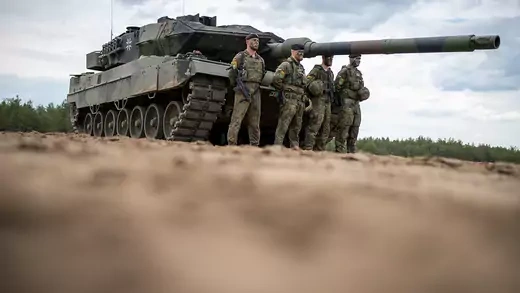Max Boot
The main battle tanks that the United States and Germany have agreed to provide Ukraine will help its forces punch through Russian fortifications and retake lost territory.
Western aid for Ukraine has steadily increased over the past year in both quality and quantity—from handheld weapons such as Javelin anti-tank missiles and Stinger antiaircraft missiles that were dispatched at the beginning of the war to much more sophisticated systems provided more recently, such as the HIMARS (High Mobility Artillery Rocket System) and the Patriot air defense system.
January 2023 marked two other milestones: the month began with Western allies finally agreeing to send advanced armored personnel carriers—the United States will contribute Bradleys and Strykers, Germany will send Marders, Sweden will send CV90s, and so on—and it ended with a breakthrough decision to send main battle tanks as well.
Britain led the way by pledging fourteen Challenger 2 tanks, but Germany refused to provide its Leopard 2 tanks until the United States agreed to send its own M1 Abrams tanks. Risk-averse German Chancellor Olaf Scholz wanted political cover from his American allies if he was going to take a step that could provoke an escalatory response from Russian President Vladimir Putin, and sending the vehicles would represent another break with Germany’s postwar quasi-pacifism.
The World This Week
A weekly digest of the latest from CFR on the biggest foreign policy stories of the week, featuring briefs, opinions, and explainers. Every Friday.
But U.S. Defense Secretary Lloyd Austin, who commanded armored units during the Iraq War, insisted that the M1 Abrams tanks would be too unwieldy for Ukraine—they require considerable maintenance and run on jet fuel. The Leopard 2, on the other hand, is slightly lighter and runs on more commonly available diesel fuel.
A standoff ensued that was finally broken this week when the Joe Biden administration agreed to send at least thirty Abrams tanks to Ukraine, though they will likely take months to arrive. This gave Scholz the opening he sought to lift his ban on providing the Leopard 2 tanks. Germany pledged to donate at least fourteen of its Leopards, while other nations such as Finland, Greece, Poland, and Spain are preparing to send their own Leopards.
First made in 1979, the Leopard 2 is one of the most potent and popular tanks in the world. It is superior to the Soviet-era tanks fielded by both Russia and Ukraine. It has modern optics and a laser range finder that enable it to track targets day and night and engage them accurately. It can move quickly (top speed: forty-four miles per hour) and it has secure ammunition storage so as to avoid the danger of its turret blowing off when hit—the “jack in the box” effect that has destroyed so many Russian T-72 tanks. The M1 Abrams is, in many respects, similar to the Leopard 2 but, in its newer variants, features even better armor and more sophisticated optics and targeting systems. The Abrams took a fearsome toll on Iraq’s Soviet-era tanks in 1991 and 2003.

A German Leopard 2 tank seen in a NATO battle group in Lithuania. Michael Kappeler/Getty Images
The goal for Ukrainian commanders is to quickly assemble at least seventy Leopard 2s—enough for two armored battalions. Of course, Ukrainian soldiers will need to be trained to operate and maintain these tanks, but given their experience operating Soviet-era tanks, this should not present any major difficulties.
These tanks could be critical to Ukraine’s prospects for mounting a successful offensive in the late winter or spring. Russia’s momentum has stalled since the early days of the war, while Ukraine has mounted successful counteroffensives around Kherson and Kharkiv, taking back about 20 percent of the territory Russia occupied in early 2022. But there is still an immense amount of territory in Ukraine’s south and east that has been occupied by Russian forces since the start of the war on February 24, 2022 (to say nothing of the territory in Crimea and the Donbas that Russia has occupied since 2014). Their front line stretches over eight hundred miles, and Russian forces have been digging in and fortifying their positions. Ukraine needs modern battle tanks such as the Leopard 2 to have any hope of punching through Russian positions without suffering appalling casualties.
Secretary Austin told me in an interview last week, while he was in Germany for a meeting of countries donating military equipment to Ukraine, that “a realistic goal for this year” would be for Ukraine to “cut the land bridge” Russian forces have established between Russia-occupied Crimea and Russia proper. That “land bridge” constitutes one of only two supply arteries for Crimea, the other being the Kerch Strait bridge that was damaged in a truck explosion on October 8. If Ukraine were able to cut the “land bridge” and destroy the Kerch Strait bridge, that could make it difficult for Russia to hold onto Crimea. Conversely, if Ukraine fails to cut the land bridge this year, Russia could pour in more men and resources and Ukraine could lose that portion of its country permanently.
Ukraine could benefit from other western capabilities as well, if they’re able to obtain them, such as longer-range rockets to target Russian bases in Crimea and fighter jets such as the U.S.-made F-16 or Swedish Gripen to provide air cover for its forces. But once the Leopard 2s are incorporated into the Ukrainian army, along with Bradleys, Strykers, CV90s, and other armored vehicles, Ukraine is likely to mount an offensive that could determine the course of the war.
No comments:
Post a Comment